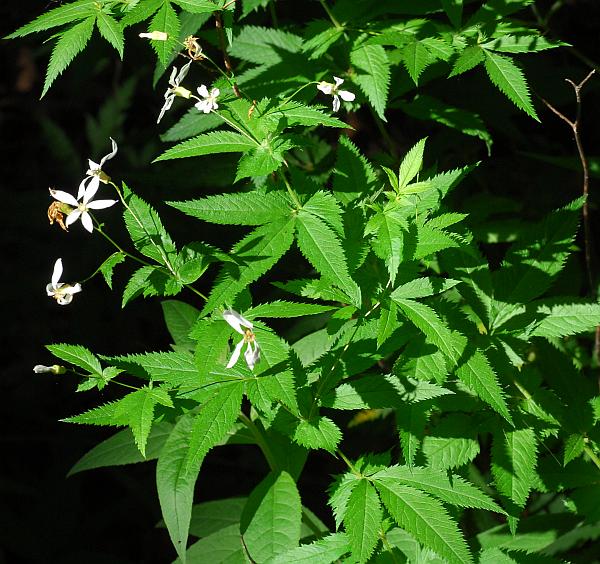Gillenia stipulata (Muhl. ex Willd.) Nutt.
Indian Physic, American Ipecac

Native
CC = 5
CW = 5
MOC = 65
© SRTurner
Gillenia stipulata (Muhl. ex Willd.) Nutt.Indian Physic, American Ipecac | |
 |
Native CC = 5 CW = 5 MOC = 65 |
© SRTurner |
|
Family - Rosaceae Habit - Perennial forb with woody rhizomes. Stems - Ascending, to 1.2 m, branching, multiple from base, glabrous to densely hairy.
Leaves - Alternate, stipulate, short-petiolate, trifoliate. Stipules 10-30 mm long, conspicuous and persistent, broadly ovate to nearly circular, the margins with numerous sharp teeth, the upper surface glabrous or with sparse nonglandular hairs, the undersurface with sessile glands, usually also with sparse to dense nonglandular hairs. Leaflets 2-10 cm long, those of the lowermost leaves usually deeply parted into narrow lobed and/or toothed lobes, those of the median and upper leaves lanceolate to narrowly elliptic, the margins sharply toothed, the upper surface usually glabrous, the undersurface with sessile glands and usually also nonglandular hairs. Leaflets of lowest leaves pinnatifid.
Inflorescence - Axillary and terminal, loose, few-flowered panicles. iInflorescence divisions subtended by reduced leafy bracts.
Flowers - Sepals 5, acute, 1.1 mm long, with some pubescence internally near apex. Petals 5, white, acute to acuminate, 1.0-1.3 cm long, 3-4 mm broad, glabrous, oblong, clawed. Claw to 3 mm long. Stamens 20, borne at edge of hypanthium, in two sets. Filaments white, glabrous, 2 mm long. Anthers tan, 1mm in diameter. Pistils 5, distinct. Styles white, 3 mm long, glabrous. Ovaries yellow-green, 1.9 mm long. Hypanthium 4-6 mm long, 3-4 mm in diameter, greenish-white to reddish, truncate at base, glabrous.
Fruits - Follicles 6-8 mm long, glabrous, with about 3 seeds.
Flowering - May - July. Habitat - Upland forests, railroads, roadsides. Origin - Native to the U.S. Lookalikes - None. Other info. - This plant is common throughout about the southeastern 2/3 of Missouri, which lies along the northwestern edge of the plant's range. From there its distribution extends mostly eastward and southward through a handful of additional states. The plant is easily recognized even when not flowering, by its distinctive sharply-toothed leaves and gigantic stipules. The flowers also have a characteristic look, which is usually somewhat asymmetric and disheveled. Photographs taken in Minimum, MO., 5-31-03 (DETenaglia); also at Cuivre River State Park, Lincoln County, MO, 6-13-2009, Taum Sauk State Park, Iron County, MO, 6-20-2011, and Little Lost Creek Conservation Area, Warren County, MO, 6-9-2017 (SRTurner). |